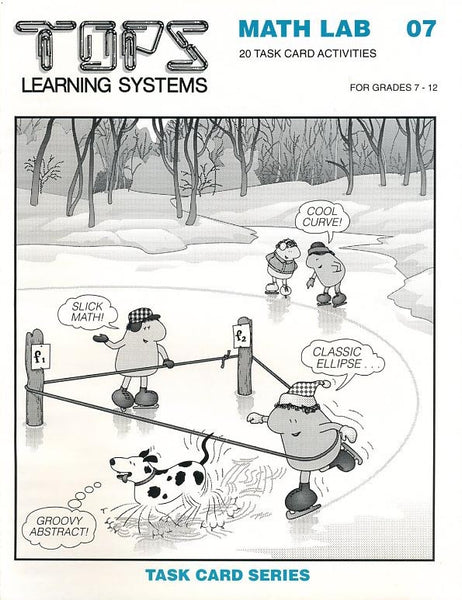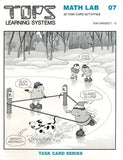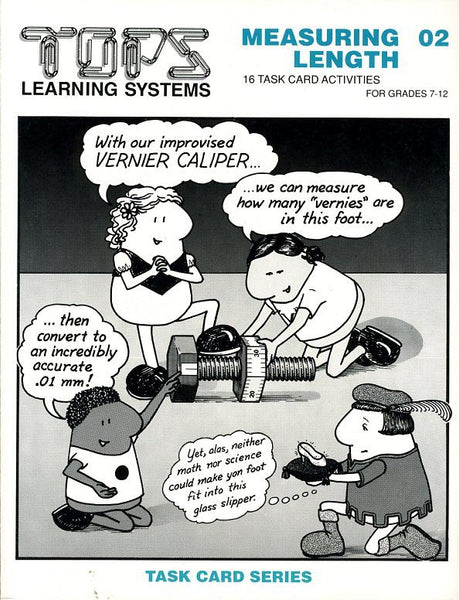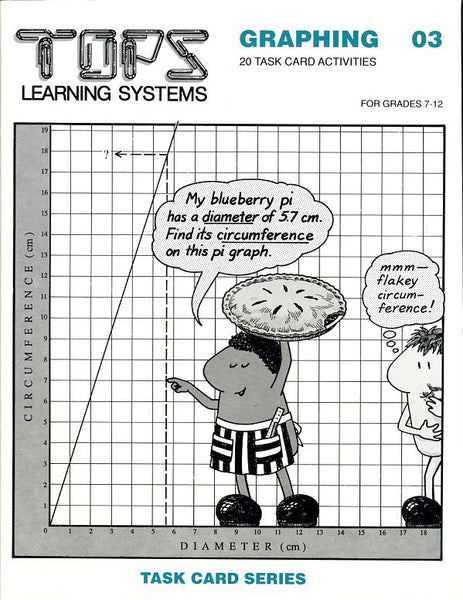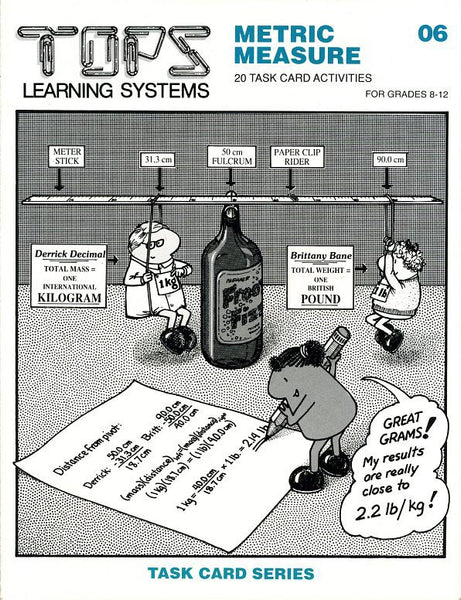#07 Math Lab (grades 7-12)
Regular price $20.95
Soft-bound, 56 page book, 20 reproducible task cards, full teaching notes.
Great hands-on math: assemble sequences with pennies, create art based on the Fibonacci sequence, fold clever curves, travel a Mobius strip. Go on to crack bar codes, solve puzzles, experience a generalization that turns out to be false. From limits to logarithms, build both math curiosity and math confidence.
Math Lab Starter Kit
book not included, please order separately
WE SUPPLY in quantities that serve one student or two students working in a lab pair: index card, clear tape, masking tape, hand lens, thread, straight pins, paper clips, styrofoam cups, adding machine tape, drawing compass, ruler, crayon
More Information – click any of the tabs below to learn more about this title
Click here for a complete list of materials and convenient shopping.
1/10/10: rolls of pennies (or index-card paper punches)6/180/180: sheets of lined notebook paper
1/30/30: sheets of copier paper
1/15/30: index cards
1/15/30: metric rulers
1/15/30: drawing compasses
1/20/30: scissors
* 1/10/10: rolls clear tape
1/7/15: hand calculators
1/30/30: sheets dark construction paper
1/5/15: bottles white glue
* 1/5/15: hand lenses (optional)
1/1/1: pencil sharpener
1/20/30: pieces 8 1/2 x 11 inch corrugated cardboard
* 1/2/2: spools thread
* 2/140/60: straight pins
1/20/30: dark crayons, wrappers removed
2/20/60: small styrofoam cups
1/5/15: short pieces pencil lead
4/120/120: sheets scratch paper
* 1/1/1: roll masking tape
* 1/2/2: boxes paper clips
* 1/1/1: roll adding machine tape
3/15/15: used envelopes with bar codes.
- Lesson 1: To discover patterns in the arrangement of pennies that form number sequences.
- Lesson 2: To discover patterns in the arrangement of squares that form number sequences. To write a general term for each sequence.
- Lesson 3: To discover patterns in the Fibonacci sequence, and apply it to a study of population.
- Lesson 4: To draw Fibonacci squares and construct the spiral of a chambered nautilus.
- Lesson 5: To study the golden mean as a ratio of Fibonacci numbers. To create a work of art based on this proportion.
- Lesson 6: To generate a sequence of regions by joining points on the circumference of a circle. To recognize the tentative nature of predictions based on generalizations.
- Lesson 7: To trace the path of a ball as it is deflected across a hypothetical pool table. To recognize the tentative nature of predictions based on generalizations.
- Lesson 8: To approximate a curve with straight lines. To recognize that n-sided polygons approach the shape of a perfect circle as n increases.
- Lesson 9: To define a circle and draw it with a smooth curve. To approximate another circle with many straight fold lines.
- Lesson 10: To define and construct an ellipse. To form a curved figure from straight fold lines and evaluate its shape.
- Lesson 11: To construct a parabola using many straight fold lines. To develop a definition based on its properties.
- Lesson 12: To define a cardioid and draw it using circles of Styrofoam. To approximate another cardioid with straight lines.
- Lesson 13: To cut and tape the interior angles of polygons, and find their sums. To understand how this sum increases as the number of sides of the polygon increases.
- Lesson 14: To discover number patterns that simplify the addition of long sequences of numbers.
- Lesson 15: To list all prime integers under 100 and examine their properties.
- Lesson 16: To develop a table of logarithms that simplify mathematical computations. To practice four basic log operations.
- Lesson 17: To discover number patterns in a slide and jump game. To generalize an nth term for each pattern.
- Lesson 18: To be surprised by the unusual topological properties of a Mobius strip.
- Lesson 19: To interpret bar codes used by the U.S. postal service that automate mail sorting.
- Lesson 20: To cut out 12 unique 5-tile puzzle pieces and use them to construct rectangles of various dimensions.
We encourage improvisation - it's one of the main goals of our hands-on approach! You and your students might invent a simpler, sturdier or more accurate system; might ask a better question; might design a better extension. Hooray for ingenuity! When this occurs, we'd love to hear about it and share it with other educators.
National Science Education Standards (NRC 1996)
Teachers of science...
A: ...plan an inquiry-based science program. (p. 30)
B: ...guide and facilitate learning. (p. 32)
C: ...engage in ongoing assessment of their teaching and of student learning. (p. 37)
D: ...design and manage learning environments that provide students with the time, space, and resources needed for learning science. (p. 43)
• Represent a central event or phenomenon in the natural world.
• Represent a central scientific idea and organizing principle.
• Have rich explanatory power.
• Guide fruitful investigations.
• Apply to situations and contexts common to everyday experiences.
• Can be linked to meaningful learning experiences.
• Are developmentally appropriate for students at the grade level specified.
Core Concepts/Processes: Induction says that what is true for the particulars is true in general. Such claims, while reasonable, are never absolutely certain.
Core Inquiries: Recognize patterns • Think inductively • Generate nth terms • Ellipses • Parabolas • Cardioids • Prime numbers • Logarithms • Solve puzzles
Core Content: Explore patterns and shapes of historical significance - the Fibonnacci series, Mobius strips, ellipses, parabolas, and the golden mean.
TEACHING Standards
These 20 task cards promote excellence in science teaching by these NSES criteria:Teachers of science...
A: ...plan an inquiry-based science program. (p. 30)
B: ...guide and facilitate learning. (p. 32)
C: ...engage in ongoing assessment of their teaching and of student learning. (p. 37)
D: ...design and manage learning environments that provide students with the time, space, and resources needed for learning science. (p. 43)
CONTENT Standards
These 20 task cards contain fundamental content as defined by these NSES guidelines (p. 109).• Represent a central event or phenomenon in the natural world.
• Represent a central scientific idea and organizing principle.
• Have rich explanatory power.
• Guide fruitful investigations.
• Apply to situations and contexts common to everyday experiences.
• Can be linked to meaningful learning experiences.
• Are developmentally appropriate for students at the grade level specified.
Unifying Concepts and Processes
NSES Framework: Systems, order, and organization • Evidence, models and explanation • Constancy, change, and measurement • Evolution and equilibrium • Form and functionCore Concepts/Processes: Induction says that what is true for the particulars is true in general. Such claims, while reasonable, are never absolutely certain.
Science as Inquiry (content standard A)
NSES Framework: Identify questions that can be answered through scientific investigations. • Design and conduct a scientific investigation. • Use appropriate tools and techniques to gather, analyze, and interpret data. • Develop descriptions, explanations, predictions, and models using evidence. • Think critically and logically to connect evidence and explanations. • Recognize and analyze alternative explanations and predictions. • Communicate scientific procedures and explanations. • Use mathematics in all aspects of scientific inquiry.Core Inquiries: Recognize patterns • Think inductively • Generate nth terms • Ellipses • Parabolas • Cardioids • Prime numbers • Logarithms • Solve puzzles
History and Nature of Science (content standard G)
NSES Framework: k458912 Science as a human endeavor • Nature of science • History of scienceCore Content: Explore patterns and shapes of historical significance - the Fibonnacci series, Mobius strips, ellipses, parabolas, and the golden mean.

